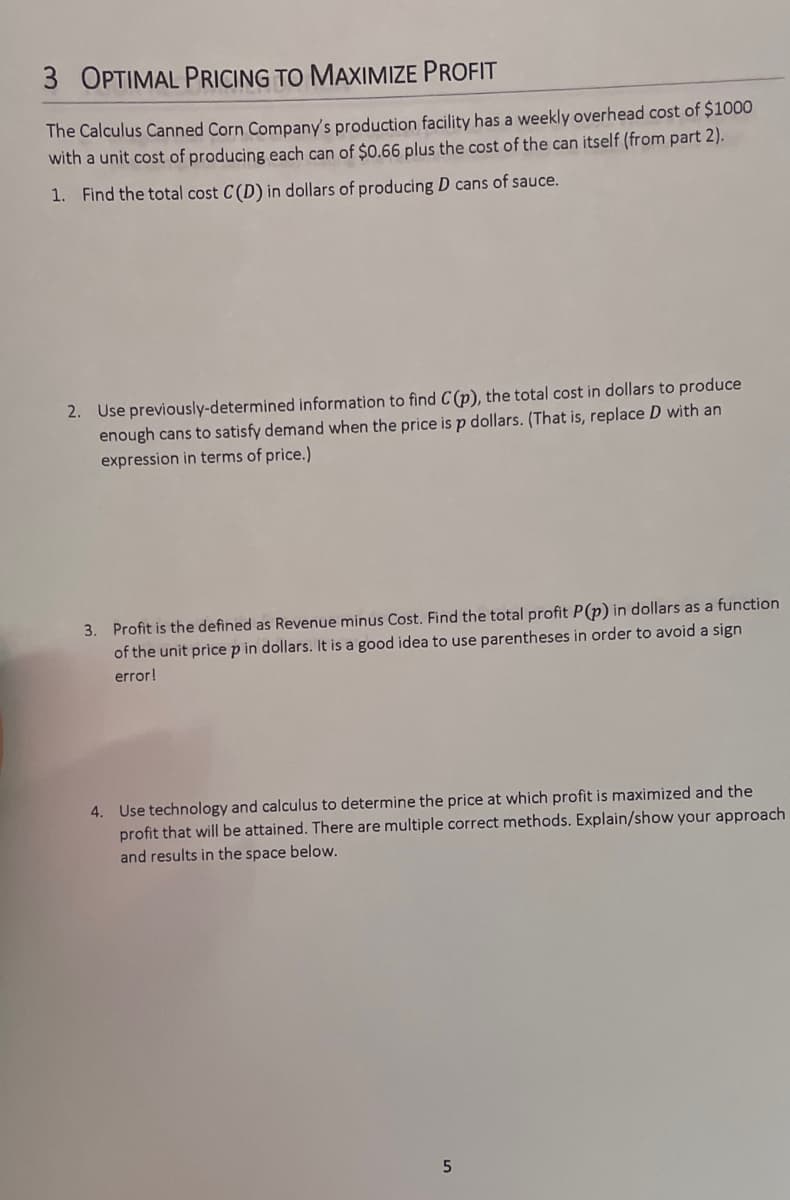1. Find the total cost C(D) in dollars of producing D cans of sauce. 2. Use previously-determined information to find C (p), the total cost in dollars to produce enough cans to satisfy demand when the price is p dollars. (That is, replace D with an expression in terms of price.) 3. Profit is the defined as Revenue minus Cost. Find the total profit P(p) in dollars as a function of the unit price p in dollars. It is a good idea to use parentheses in order to avoid a sign error! 4. Use technology and calculus to determine the price at which profit is maximized and the profit that will be attained. There are multiple correct methods. Explain/show your approach and results in the space below.
1. Find the total cost C(D) in dollars of producing D cans of sauce. 2. Use previously-determined information to find C (p), the total cost in dollars to produce enough cans to satisfy demand when the price is p dollars. (That is, replace D with an expression in terms of price.) 3. Profit is the defined as Revenue minus Cost. Find the total profit P(p) in dollars as a function of the unit price p in dollars. It is a good idea to use parentheses in order to avoid a sign error! 4. Use technology and calculus to determine the price at which profit is maximized and the profit that will be attained. There are multiple correct methods. Explain/show your approach and results in the space below.
Calculus: Early Transcendentals
8th Edition
ISBN:9781285741550
Author:James Stewart
Publisher:James Stewart
Chapter1: Functions And Models
Section: Chapter Questions
Problem 1RCC: (a) What is a function? What are its domain and range? (b) What is the graph of a function? (c) How...
Related questions
Question
100%
*3>OPTIMAL-PRICING-TO-MAXIMIZE-PROFITT
The-Calculus-Canned-Corn-Company's-production-facility-hasa-weekly-overhead-cost-of-$1000
with-a-unit-cost of producing each-can-of. $0.66- plus the-cost of the can-itself (from part-2). The cost of the can is $6 from part 1

Transcribed Image Text:3 OPTIMAL PRICING TO MAXIMIZE PROFIT
The Calculus Canned Corn Company's production facility has a weekly overhead cost of $1000
with a unit cost of producing each can of $0.66 plus the cost of the can itself (from part 2).
1. Find the total cost C(D) in dollars of producing D cans of sauce.
2. Use previously-determined information to find C (p), the total cost in dollars to produce
enough cans to satisfy demand when the price is p dollars. (That is, replace D with an
expression in terms of price.)
3. Profit is the defined as Revenue minus Cost. Find the total profit P(p) in dollars as a function
of the unit price p in dollars. It is a good idea to use parentheses in order to avoid a sign
error!
4. Use technology and calculus to determine the price at which profit is maximized and the
profit that will be attained. There are multiple correct methods. Explain/show your approach
and results in the space below.
Expert Solution
This question has been solved!
Explore an expertly crafted, step-by-step solution for a thorough understanding of key concepts.
Step by step
Solved in 4 steps

Recommended textbooks for you

Calculus: Early Transcendentals
Calculus
ISBN:
9781285741550
Author:
James Stewart
Publisher:
Cengage Learning

Thomas' Calculus (14th Edition)
Calculus
ISBN:
9780134438986
Author:
Joel R. Hass, Christopher E. Heil, Maurice D. Weir
Publisher:
PEARSON

Calculus: Early Transcendentals (3rd Edition)
Calculus
ISBN:
9780134763644
Author:
William L. Briggs, Lyle Cochran, Bernard Gillett, Eric Schulz
Publisher:
PEARSON

Calculus: Early Transcendentals
Calculus
ISBN:
9781285741550
Author:
James Stewart
Publisher:
Cengage Learning

Thomas' Calculus (14th Edition)
Calculus
ISBN:
9780134438986
Author:
Joel R. Hass, Christopher E. Heil, Maurice D. Weir
Publisher:
PEARSON

Calculus: Early Transcendentals (3rd Edition)
Calculus
ISBN:
9780134763644
Author:
William L. Briggs, Lyle Cochran, Bernard Gillett, Eric Schulz
Publisher:
PEARSON

Calculus: Early Transcendentals
Calculus
ISBN:
9781319050740
Author:
Jon Rogawski, Colin Adams, Robert Franzosa
Publisher:
W. H. Freeman


Calculus: Early Transcendental Functions
Calculus
ISBN:
9781337552516
Author:
Ron Larson, Bruce H. Edwards
Publisher:
Cengage Learning